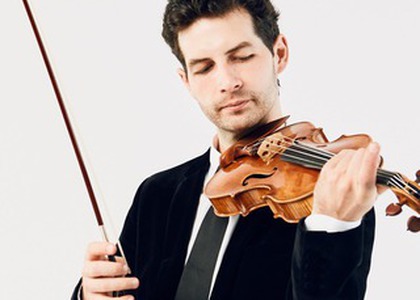> Interviews

Interview with violonist Valentin Serban (II)
On February 12th, on the Radio Hall stage, violinist Valentin Serban and pianist Daria Tudor will perform a recital under the aegis of the project "The Heirs of Musical Romania". Tickets for the recital entitled Violin in love are already on sale, being the first event organized by Radio România Muzical and Rotary Club Pipera, in collaboration with Artexim.
After winning first prize at the "Enescu" Competition, you continued to perform in chamber music recitals. Besidesthe work as soloist, is there something that still attracts you to chamber music?
First of all, I am attracted by diversity. I also like to play in an orchestra, I like to play solo with the orchestra and I really like the chamber part, whether it's a trio or a quartet or a duo.I think they all complement each other.When you only do one part, you're probably more limited, at least that's what I think, and then yes, I want to do as much chamber music as possible. Sure, it requires other approaches, playing solo is a selfish, so to speak, but necessary act.You're up front, you have to be imposing, but playingchamber is 100% collaborative, it's totally different, it's a whole, not just one. So is playing in an orchestra, you have to adapt to a whole violin part or the whole orchestra, in any context. So, yes, they complement each other, they are very different and they certainly broaden the horizon of any musician who practices them.
I would like to know, from your experience, are there differences between the audiences? Is there an audience for chamber recitals, is there an audience that only comes to concerts?
Unfortunately, what I have noticed is that there's no tradition of chamber music in Romania. There aren't many seasons and I don't think there's a specially formed audience for it. Which is a big minus and I hope it will change, these radio recitals are extremely important in this sense.
There is, however, interest from musicians in this regard, with supply likely to increase and demand, we suppose.
Sure. A lot of times there's the mentality, "we can't do this because it's not required," but I think it's a trade-off. I think you provide and then the demand slowly grows, even though it can be certainly more complicated at first, but I think you have to push it in that direction.In my opinion, music is the highest form of art, in terms of spirituality, sensibility and inspiration, and chamber music is such after all. I think it can be the most demanding. At least that's what I've discovered, and what I find most fulfilling is this collaboration in two, three or even enough to form a chamber orchestra.When there are more people creating music, there are more possibilities. A solo concert, regardless of the instrument, is about a lead musician and an accompanying orchestra. It's somewhat limited in that way, but only in a duo or a trio or a quartet.All musicians are equally involved and, at that moment, the possibilities of expression are increased, there are more participants.
And since I was talking about the audience earlier, I'd like to know, how do you think we could attract young people to classical music?
This is a question I think all musicians ask themselves, because we struggle with it. We want to attract a younger audience, to create an audience for the future.I don't know the solution. If therewas a known solution, the situation would probably be different, but I think there are some formalities that prevent us from approaching young audiences. That's why there are often soloists who come on stage in coloured shirts, or who don't come in formal wear like in the 50s, with bow ties, tailcoats and tuxedos. They're trying to get closer to a youth who may be liberal, who may shy away from these formalities, which are often seen as rather old-fashioned. In my opinion they have their charms, but I think there may be a direction: approach through simplicity, by breaking away from certain patterns.
Translated by Andreea Zofotă,
University of Bucharest, Faculty of Foreign Languages and Literatures, MTTLC, year II
Corrected by Silvia Petrescu














